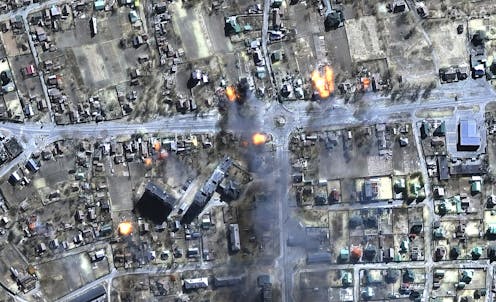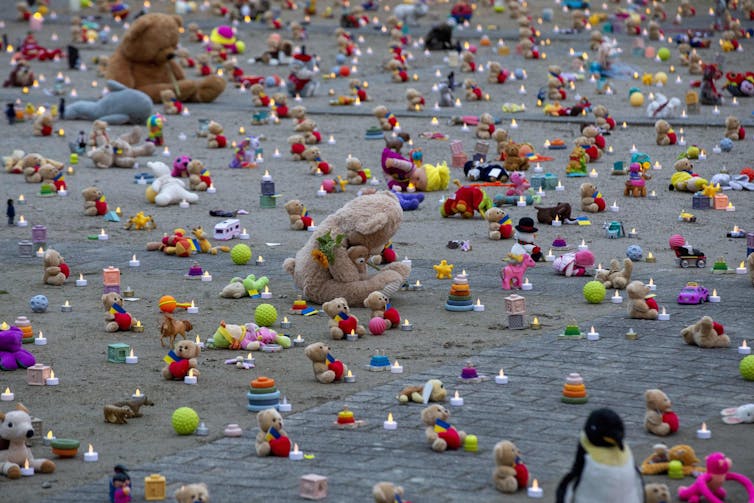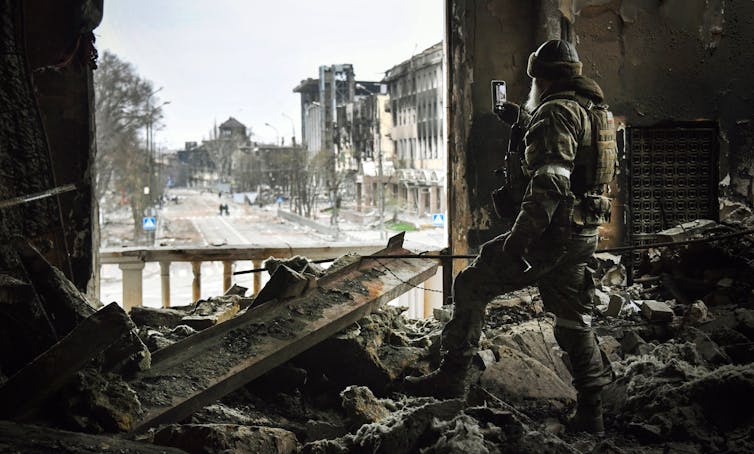The International Criminal Court is using digital evidence to investigate Putin – but how can it tel
Digital evidence is becoming a routine fixture for war crimes investigations, including the one focused on Ukraine, changing the landscape for international tribunal investigations.

Russia’s invasion of Ukraine in February 2022 was reminiscent of wars long past, where a country invades another with little provocation.
But there are many parts of this conflict that are uniquely modern – including how ordinary Ukrainians are capturing and sharing videos and photos documenting the mass murder of civilians, which is considered a war crime under international law.
The International Criminal Court – an international tribunal in the Hague, Netherlands, designed to investigate and prosecute war crimes – is trying to keep pace with this trend.
The ICC, a common acronym for the court, issued arrest warrants for Russian President Vladimir Putin and Russia’s children’s rights commissioner, Maria Lvova-Belova in March 2023. They are charged with allegedly abducting and deporting Ukrainian children to Russia.
It isn’t clear what specific evidence ICC prosecutors have gathered to support these charges, but ICC prosecutor Karim Khan has spoken about the “advanced technological tools” the court is using in its ongoing investigation. This could include, for example, satellite imagery or cellphone video filmed by witnesses.
I am a scholar of international human rights who has studied the ICC’s investigations into war crimes in Mali, West Africa, and how the court’s use of such digital evidence has advanced over the last decade.
The ICC’s current investigation in Ukraine could further cement this shift toward using digital evidence to investigate war crimes – and raises new challenges about verifying the authenticity of these photos and videos.

A rise in digital forensics
War crimes investigations have traditionally relied almost exclusively on witness testimony and mud and bones forensics from crime scenes.
This began to change in 2013, when the ICC investigated Malian jihadist Ahmad Al Faqi Al Mahdi, who ordered the destruction of shrines and mosques in Timbuktu during an occupation of this city in Mali.
Video evidence documented the destruction of these holy sites, which are UNESCO heritage sites. Al Mahdi’s group took some of these videos, and international media filmed others.
Prosecutors ultimately had such a large trove of video evidence that they organized them into a digital visual platform.
For the first time, the ICC relied heavily on visual digital evidence in a prosecution.
The court sentenced Al Mahdi to nine years in prison in 2016 for destroying Timbuktu’s history.
Since then, other international tribunals have accepted digital videos and images as legitimate evidence. Satellite imagery, mobile phone videos and other sources of digital data can offer powerful supplements to eyewitness accounts of war crimes.
Is it real or fake?
With the rise of advanced video editing and artificial intelligence tools, it can be challenging to tell real videos or images from fake ones. If investigators are unable to guarantee that the evidence they download is real, they are unable to proceed with their work.
The University of California Berkeley School of Law’s Human Rights Center raised this point in 2022, when it released a guide on digital evidence intended for international court investigators, lawyers, and judges.
This guide, known as the Berkeley Protocol, sets standards for legal relevance, security and the handling of digital evidence. This includes guidance for investigators, such as protecting the identity of witnesses who provide digital evidence and awareness of the psychological effects of viewing disturbing content.
There are several stages to a digital investigation, as the guide explains.
The first involves getting the evidence. Investigators sometimes find themselves in a race to download and preserve digital content before a content moderator – a person or an AI-enabled tool – deletes it and it disappears.
Once a video is safely in their possession, analysts have to authenticate it. This complicated process involves establishing where the evidence came from and where else it has been, from the time and place the video was shot to the point when investigators acquired it.
In their analysis, investigators look for things like distinctive buildings or trees that can be easy to spot in other images. Satellite imagery can also help determine exactly where a video was filmed and what direction the camera was pointed. Investigators may also use tools like facial recognition software.
Video images often contain other clues about the time and location of an incident. Things like street signs or sticker graffiti on lampposts can help narrow down where and when an image was filmed and what it shows.
The ICC is now using the Berkeley Protocol in its investigation of Ukraine. If and when the time comes for prosecutors to present digital evidence of Russian war crimes in court, there will be little need for lawyers to argue over its validity.

The digital evidence so far for Ukraine
It isn’t likely that Putin or Lvova-Belova will be arrested – at least, not any time soon. For now, they are safe by staying within Russia’s borders, since Russia does not abide by the ICC’s arrest warrants or prosecutions.
But the court’s investigation of Russian war crimes is ongoing, and it will rely on the thick trail of digital evidence that journalists, regular citizens and even perpetrators themselves have documented over the course of the Ukraine war.
The Associated Press published images and video in March 2023 of Ukrainian children – who may or may not be orphans – being loaded onto buses in the Donetsk region of Ukraine, and others of Ukrainian children eating together in Russia.
Two research agencies that previously consulted for the ICC have also released their own visual investigations of war crimes in Ukraine, showing digital evidence that Russian artillery attacked a theater in Mariupol where civilians took shelter in March 2022, for example.
Perpetrators, too, are posting evidence of their alleged crimes. Russian state media has reportedly shown Russian soldiers taking Ukrainian children from a group home into Russian territory.
International tribunals are adapting to the new landscape of digital documentation. There are scenes in Ukraine that look eerily like the conflicts of the 20th century, but the current war crimes investigation is unlike anything we have seen before.
Ronald Niezen received funding from the Social Sciences and Humanities Research Council of Canada.
Read These Next
George Washington’s foreign policy was built on respect for other nations and patient consideration
For the nation’s first president, friendliness was strategy, not concession: the republic would treat…
The 6-7 craze offered a brief window into the hidden world of children
From Pig Latin to Punch Buggy, kids have long used nonsensical language, gestures and games to carve…
Why the Pittsburgh Post-Gazette’s closure exposes a growing threat to democracy
When reputable local news outlets close, fewer people vote and get involved in local politics, and misinformation,…






